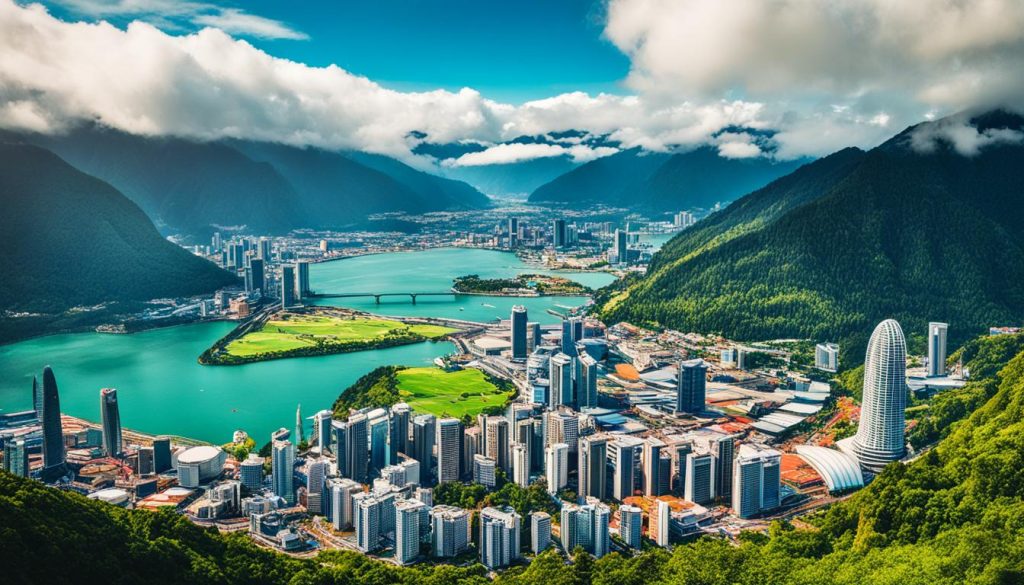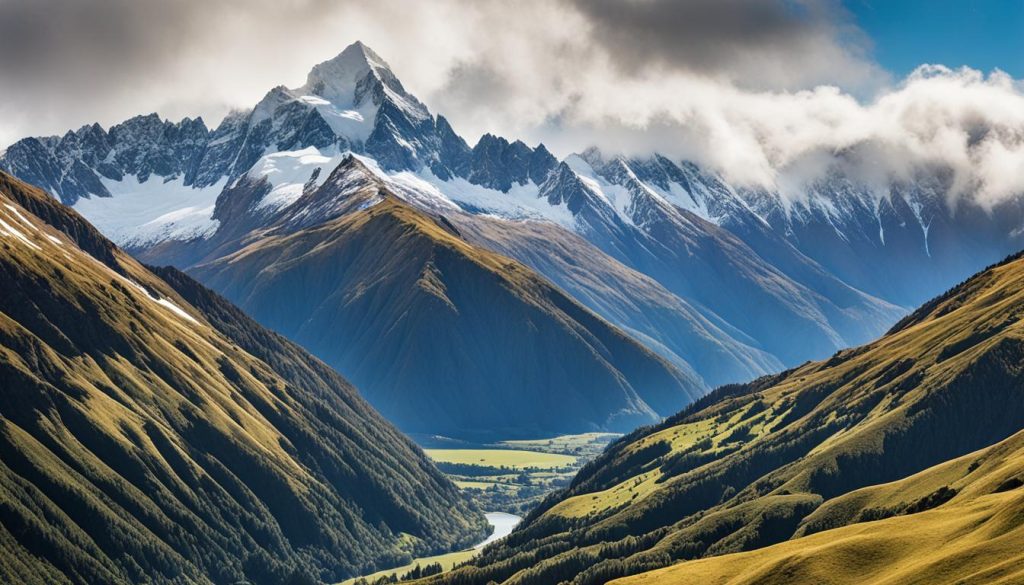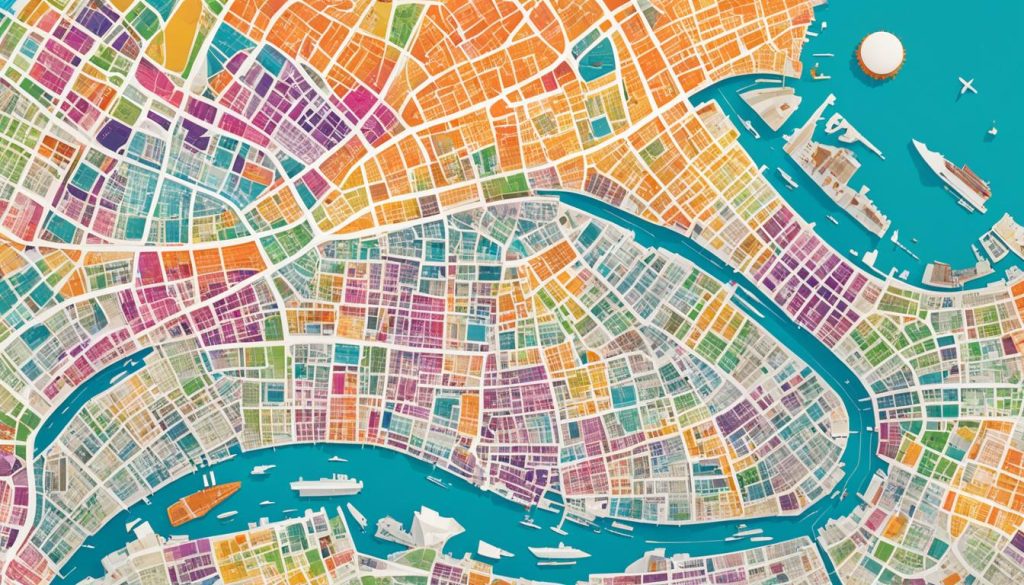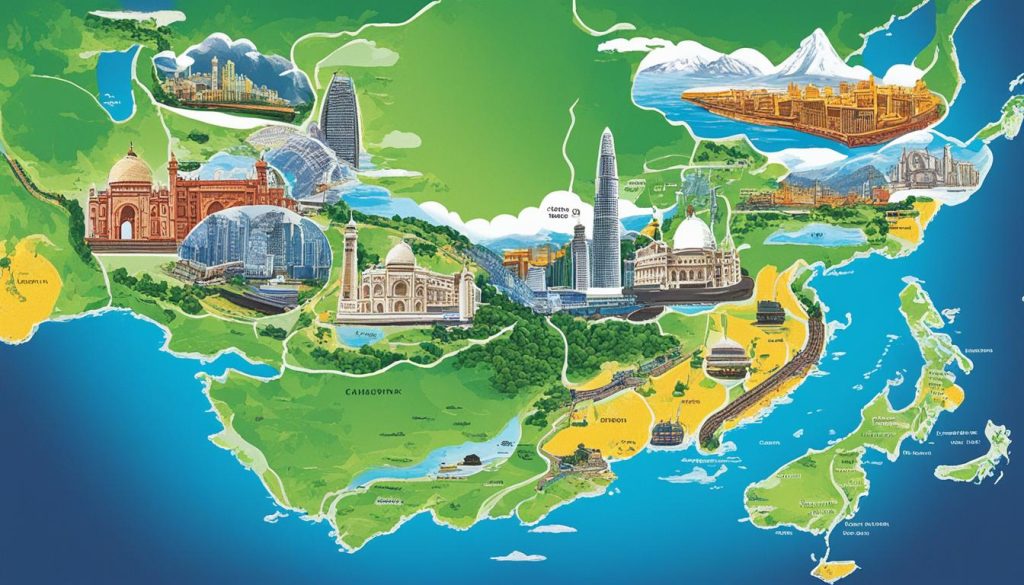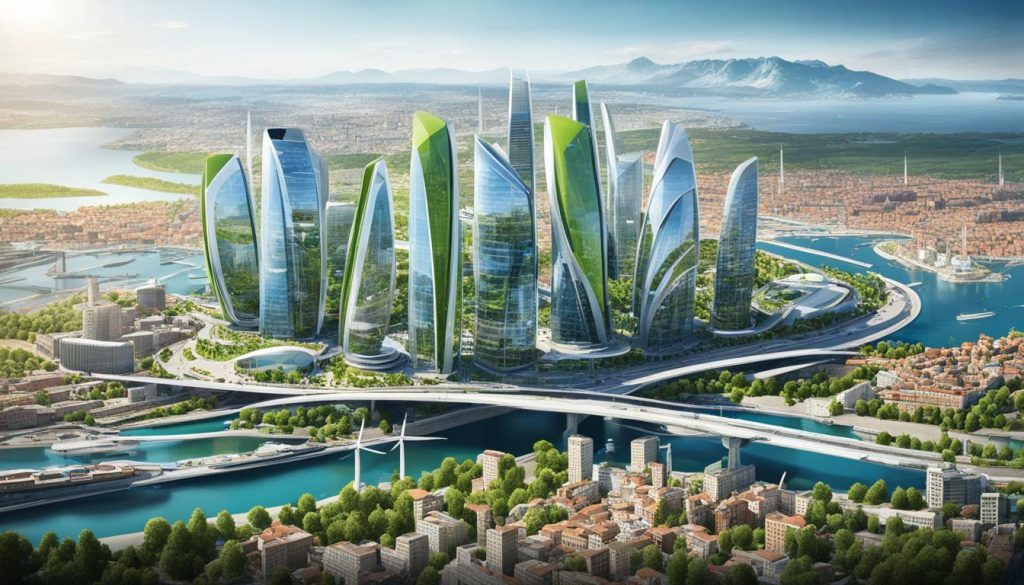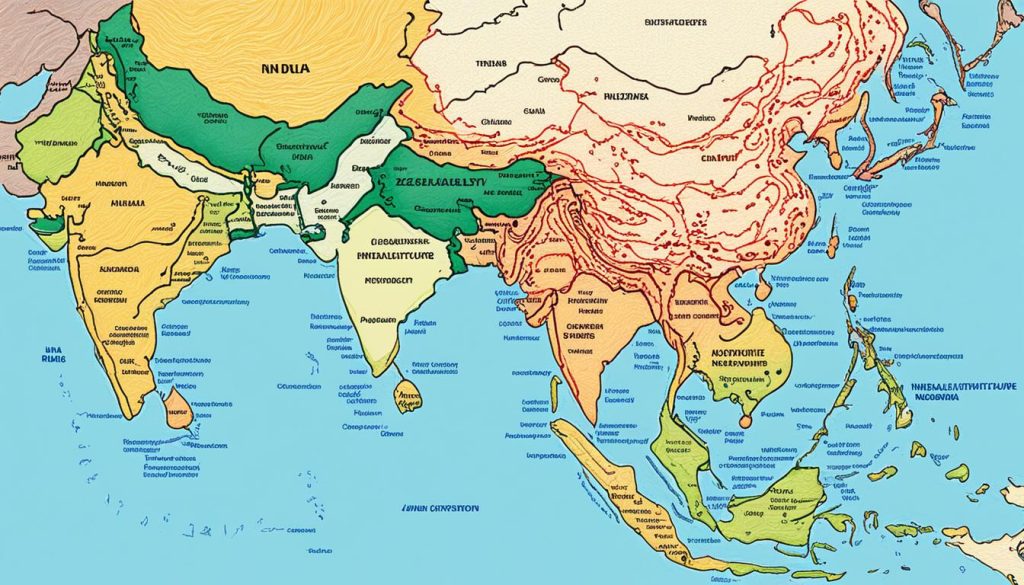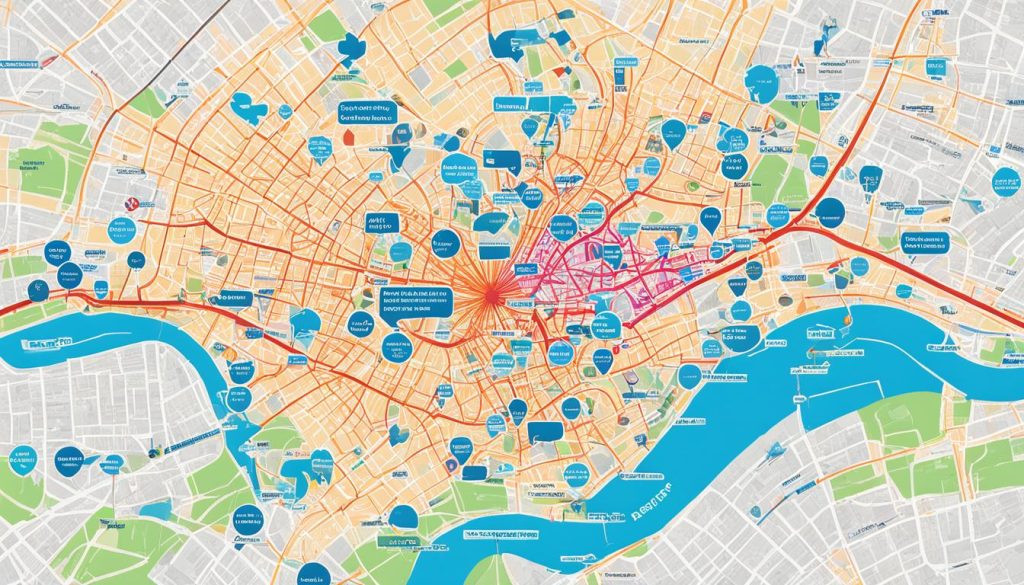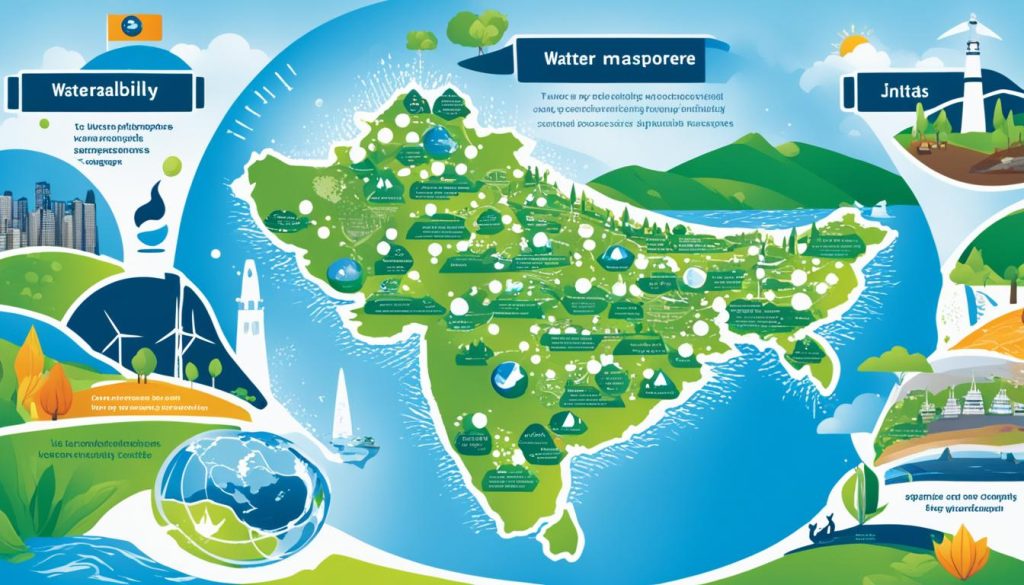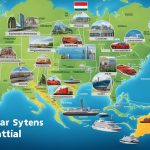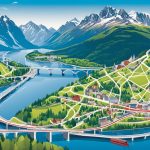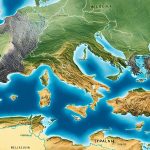From Mumbai’s busy streets to the peaceful Bay of Plenty, then to Singapore’s advanced skyline, these places show us different worlds. We explore how their land, population, and infrastructure development paint a unique picture. India, New Zealand, and Singapore each show unique ways to grow, surrounded by their own landscapes and challenges.
Looking at India, New Zealand, and Singapore, we see more than lands and buildings. It’s about how geography drives their economy and affects people’s lives. Through understanding their infrastructure, we see the big picture. This story shows us the power of landscapes in shaping a nation’s future.
Overview of Geographic Landscapes
Exploring different landscapes shows the special geographic features of each place. New Zealand’s landscape has mountains and big coastal plains. Especially in the South Island, you’ll find the dramatic Southern Alps. The North Island is known for its volcanoes and wide shores.
India is very different. The Himalayas stand tall in the north. The fertile Ganges plain is one of the biggest flat areas in the world. Also, India’s coastline is 7,000 km long. It offers varied climates and landscapes, adding to the nation’s natural riches.
Singapore might be small, but it’s got a well-developed city. Thanks to clever land use, it has top-notch infrastructure despite its size.
- New Zealand’s long coastline promotes a marine-rich environment, known for its diverse sea life and water sports.
- India has varied terrains from the Thar Desert to the Sundarbans. These landscapes shape its cultures and ways of life.
- Singapore uses its space wisely, blending functionality with beauty in its crowded city.
Different countries show us how geography influences identity, culture, and economy. Mountains, flatlands, or cities, each plays a key role.
Natural Resources and Environmental Concerns
Exploring the natural riches of lands shows us how closely tied they are to growing environmental issues. Every country’s unique way of dealing with their natural resources shows how serious they are about sustainability. We will see how these countries manage the delicate balance between using and keeping their environment safe.
Forests and Biodiversity
New Zealand is impressive with about one third of it covered in forests. These forests are key for keeping different species safe and healthy. In India, even with a bit less forest, there’s still a great 23.1% helping to protect a wide range of life. Forests do more than just store carbon; they are crucial for the earth’s well-being.
Agricultural Land and Food Security
New Zealand mainly uses its land for farming animals, making sure it has plenty of food from livestock and dairy. India, on the other hand, uses more land for crops. This is because it has many more people to feed and focuses on having enough food for everyone.
Environmental Issues and Sustainability Challenges
Each country’s environmental problems depend on their specific situations and how built-up they are. Both India and New Zealand are fighting deforestation and climate change. For India, it’s even tougher due to its many people. New Zealand has big issues with soil washing away. In busy Singapore, they are coming up with new ways to plan cities that are good for the environment, setting examples for others to follow.
- Biodiversity conservation requiring concerted forest cover management
- Safeguarding food resources through sustainable agricultural practices
- Emerging climate change effects demanding robust habitat protection measures
- Focusing on land utilisation that harmonises development with environmental integrity
Population Distribution and Density Contrasts
An exploration of population density, urban sprawl, and demographic distribution shows deep contrasts. Places like Singapore, New Zealand, and India show this. Their numbers tell us how people live and affect their surroundings.
Singapore’s population density stands out, with 7,804 people per square kilometre. This leads to vast urban sprawl. Such density forces the city-state to find new ways to plan cities and live closely.
On the other hand, New Zealand is much less crowded. It has only 18 people per square kilometre. This low density spreads people out, making it hard to deliver services over large areas.
- Impact of Density on Infrastructure in Singapore
- Challenges of Urban Sprawl and Resource Distribution
- Managing Demographic Distribution in New Zealand
India sits between these examples with a large population but similar challenges. Its cities overflow, putting strain on resources, services, and living spaces.
- Comparing Urban Densities and Living Conditions
- Demographic Distribution and its Socioeconomic Implications
- Strategies to Mitigate Urban Sprawl
This shows how countries try to manage growing populations. They work to expand cities and keep living standards up while balancing resources.
Climate Variability and Its Impact
India, New Zealand, and Singapore experience very different weather patterns. These conditions greatly affect their environments and how people live. In New Zealand, the weather changes a lot because of things like volcanoes and earthquakes. It has microclimates ranging from sunny beaches to snowy mountains, showing its weather variety.
In India, the weather varies from the tropical monsoon in the south to the cooler Himalayan north. This weather diversity impacts farming, how people live, and even building styles. The monsoon rains are essential for water and crops but also cause floods and transport problems.
Singapore has a stable, humid climate due to its equatorial position, with constant temperatures and lots of rain. This consistent weather affects city planning and how resources are managed. It’s especially vital because Singapore has limited space and many people.
- Sharp climatic contrasts in New Zealand invite a variegated experience of nature’s unpredictability.
- India’s climatic range from tropical monsoon to temperate influences its agrarian practices and daily life.
- Singapore’s tropical climate necessitates innovative approaches to its urban and environmental nuances.
Understanding these different climates is key to tackling ecological risks and maintaining the well-being of their populations. How these countries handle their diverse weather conditions is crucial. It helps them stay strong in the face of global environmental changes.
Infrastructural Development and Economic Growth
Infrastructure shows economic growth and aids it. When looking at countries worldwide, the differences in GDP per capita highlight economic development and living standards. The design of a city and its infrastructure heavily influences its liveability and future.
Singapore, New Zealand, and India have taken unique routes in developing their cities. This affects their citizens’ quality of life.
GDP Comparison and Living Standards
Singapore’s high GDP per capita points to great living standards and a booming economy. The country pours resources into quality healthcare, education, and cutting-edge technology. This reflects its wealth.
In contrast, New Zealand’s lower GDP means a steady economy. It has blended urban growth with nature well. This mix has made its living standard desirable.
Urbanisation and Quality of Life
Urbanisation can be good and bad. The way a city is planned and managed makes it liveable. In Singapore, careful planning means top-quality life infrastructure.
New Zealand’s cities, less crowded, offer openness. This adds value to their urban development. India presents a vibrant city scene with unique infrastructural issues against a growing economy.
Healthcare Systems: A Comparative View
New Zealand puts a big focus on public healthcare for its people. It makes sure everyone can afford healthcare. Singapore, on the other hand, has a mix of savings and insurance for healthcare. This makes access to healthcare different from New Zealand.
In terms of hospitals, New Zealand is well-prepared with many beds for its people. Singapore uses its resources wisely, focusing on stopping illnesses before they start. This means they need fewer hospital beds but still provide great care.
- The provision and accessibility of public healthcare in New Zealand.
- Hospital infrastructure and the ratio of beds per inhabitant.
- Difference in healthcare models and access between New Zealand and Singapore.
Though their methods differ, both countries aim to provide good healthcare. They follow different paths to make healthcare available to everyone. But, their core goal—to give accessible healthcare—remains the same.
Educational Frameworks and Expenditure
How much a country spends on education investment is key to its future. Educational quality and development get a big boost in New Zealand with 6.3% of its GDP spent. This shows they really value nurturing their youth.
Singapore, though, spends just 2.9% of its GDP on education. Yet, the focus is on using these funds efficiently for high standards. Both countries have their own successful methods in supporting education, proving there’s more than one way to enhance learning.
School expectancy reveals a lot about education’s impact. New Zealand offers a longer school journey, giving its students a well-rounded educational experience. The length of schooling can shape a nation’s future by improving skills and economic growth.
Let’s look at the differences in educational efforts and results:
- Percentage of GDP allocated to education:
- New Zealand: 6.3%
- Singapore: 2.9%
- School life expectancy:
- New Zealand: Notably longer, for a broad education
- Singapore: Shorter, but aimed at high achievement
- Focus areas and outcomes:
- New Zealand: Aims for a varied education to build different skills
- Singapore: Focuses on specialist knowledge in specific areas
These factors not only show where countries are now but also hint at future educational quality. They reveal the value that societies place on learning and innovation. Understanding these educational strategies helps us see what makes a country competitive globally.
Transportation Networks and Accessibility
The success of any society depends on good transport networks. How well public transport, roads, and railways connect shows a country’s commitment to moving people and goods efficiently. These networks impact how easily citizens can travel.
Public Transport Efficacy
Singapore is a world leader in public transport. Its system is easy to use, always on time, and very clean. These qualities make Singapore’s transport system a model for urban mobility around the world.
Road and Railway Infrastructure
New Zealand and India need different transport strategies due to their size and landscape. In India, trains connect distant areas and bring people together. New Zealand’s less crowded spaces deal with hills and valleys, requiring cleverly planned roads.
- Public transit systems in urban centres as a gauge for national accessibility.
- Transport efficiency through the lens of transit frequency and reliability.
- Enhancing rail connectivity to bolster economic and social cohesion.
- Strategic development of road infrastructure maximising regional strengths.
Better transport is not just about moving around. It helps the economy grow and brings people closer. The quality of a country’s transport shows what it values in development.
Water and Energy Utilities: Assessing Resource Management
Managing utilities like water and energy is key to keeping a country’s supplies running smoothly. Resource management is the backbone, ensuring these services are delivered efficiently. Good management helps economic growth and keeps our environment balanced, very important in today’s world.
In New Zealand, using hydropower is a great way of using natural resources for energy. They also use natural gas well, showing how to provide energy sustainably. Meanwhile, India needs to diversify its energy sources, as it relies a lot on coal. This is against the background of a huge irrigation network essential for its agriculture and a big user of water.
Singapore uses its small size to think out of the box in managing resources. It invests in technology to make water and energy supplies very efficient. Techniques like desalination and NEWater are key to Singapore’s plan to make sure it has enough water through smart methods.
- Hydropower and natural gas strategies in New Zealand
- India’s coal dependency and irrigation demands
- Singapore’s technological approach to utility services
This comparison shows how different countries tackle resource management. Each nation’s geography, economy, and tech affect how they manage water and energy. Looking into their methods helps us understand the complex world of global resource management better.
Communication Infrastructure: Connectivity and Reach
Singapore aims for a highly connected future. It is known for top-notch communication networks. These are key for its smart city goals and lively economy. The city has a wide broadband network and strong digital infrastructure. This makes it a worldwide center for data exchange and new digital services.
In New Zealand, the goal is to close the digital gap between rural and urban areas. There are big investments to extend broadband to remote places. This effort connects distant communities and improves digital interaction.
India has big plans to expand broadband and strengthen its digital setup. Communication networks are vital for improving the lives of its huge population. They provide access to education, healthcare, and economic opportunities. The aim is to reach everyone, not just those in cities, with these benefits.
- Expanding high-speed internet capabilities across varied terrains.
- Upgrading existing networks to facilitate greater data throughput.
- Encouraging digital literacy and technology adoption at grassroots levels.
- Improving the resilience and security of communication networks against cyber threats.
These countries are working hard to improve broadband and communication networks. This shows how crucial digital infrastructure is today. As we go further into the digital age, the differences in how these networks are built will shape their future in the global scene.
Land Use Patterns and the Balance with Nature
Looking at how New Zealand and India use their land highlights their challenges and goals, especially in sustainable agriculture and achieving food sovereignty. Both countries try to balance using their lands productively and keeping them for the future. Their strategies show a deep care for prosperity and environmental conservation.
Agricultural Practices and Self-sufficiency
In New Zealand, the focus is on farming cattle and sheep, which supports their economy. This approach not only brings profits but also keeps natural grasslands safe and reduces the need for large-scale crop farming. On the other hand, India faces the huge challenge of feeding its large population. It relies on growing crops on a lot of land. While this is crucial for feeding the nation, it poses questions about how long such intense farming can continue.
Conservation Efforts and Protected Areas
New Zealand works hard to protect large areas of its beautiful forests. This shows its commitment to keeping natural habitats safe. In contrast, India must balance development needs with protecting its diverse wildlife. Creating wildlife sanctuaries and national parks shows India’s dedication to preserving its natural areas despite development pressures.
Economic Indicators: Inflation, GDP, and Employment
Economic indicators are crucial for assessing a country’s financial health. They help measure economic stability, a goal for nations worldwide. In places like Singapore and New Zealand, effective policies influence inflation rates, Gross Domestic Product (GDP), and job markets. Such strategies shape what citizens can achieve.
In Singapore, keeping unemployment low is key to their plan. This approach makes Singapore a model of economic stability. A stable economy leads to a strong job market. The government then promotes career growth and skills enhancement.
- Low unemployment shows a country has a healthy job scene, crucial for economic steadiness.
- GDP growth rates indicate how well a country is doing financially and its overall income.
- A steady inflation rate is vital for sound economic plans and investments.
In New Zealand, building a strong economy involves tackling unique challenges with specific policies. Here, the aim is to create a varied and flexible job market. This helps weather international economic shifts. Keeping inflation rates in check ensures people can afford to buy goods and retain confidence in their economy.
Different methods in managing inflation rates and debts show the diverse approaches to economic stability. In today’s connected world, the impact of financial movements is global. It underscores the need for robust economies and adaptable job sectors.
By examining these indicators, investors and the public get insights into the economy. This info is not just a snapshot of now but helps predict future trends. It shows how stable the economy might be moving forward.
Living Quality Indices: Happiness and Health
Quality of life measures are key to understanding national wellbeing. They go beyond just economic indicators. This shows what makes life worth living. The happiness index is crucial here, looking at things like money security, friendships, and good health.
When we look at health, life expectancy and death rates tell us a lot. These numbers show how well a country keeps its people healthy. New Zealand is a great example. Its strong public health system is vital for its people’s great life quality.
Singapore, even without a universal health system, still has outstanding health outcomes. Its residents live long and healthy lives. This proves how effective its health policies and practices are.
- Assessment of subjective wellbeing through happiness indexes.
- Evaluation of health outcomes by reviewing nationwide statistics on life expectancy and mortality rates.
- Examination of how public healthcare systems impact the quality of life measures, with a focus on New Zealand’s approach.
- Analysis of Singapore’s healthcare outcomes and the strategies contributing to its citizens’ longevity and health.
Looking at different ways to improve wellbeing and healthcare shows something important. Quality of life measures give us a full view of real wealth. It moves our attention from just money to living a happy and healthy life.
International Rankings: Corruption Perception and Economic Freedom
In our world, everyone wants clear and honest dealings. Rankings like the Corruption Perceptions Index help us see how governments perform in honesty and effectiveness. Countries such as New Zealand are proud of their good standings. They show a strong fight against corruption. This makes people and investors trust them more.
Similarly, Singapore is well-known in the economic freedom index. It’s leading in creating a business-friendly climate. Here, businesses grow with little government meddling. This ensures a lively and strong market economy.
These rankings matter a lot more than just being an honour. They shape how the world sees a country, making it more inviting for foreign investments. They even affect national credit scores. Linking corruption perception with economic freedom tells us much about a nation’s values. It shows how much they follow the rule of law.
Countries use these indices to look at how well they govern. They also help them aim for better policies. These should foster honest behaviour and economic opportunities.
- High Scores in Corruption Perceptions Index – this points out New Zealand’s commitment to keeping things open and fighting corruption.
- Leadership in Economic Freedom – This underlines Singapore’s effort to boost trade, investment, and the rights of property owners.
Conclusion
In our journey, we looked at India, New Zealand, and Singapore. Each place has its own challenges and strengths. We’ve seen how each country’s culture and economy play a big part in its global role. This journey into country comparison gave us deep geopolitical insights. It showed us how each country adapts and stays strong.
We saw how vital roads, schools, healthcare, and utilities are. They tell us more than just about India’s growth, New Zealand’s peace, or Singapore’s innovation. By looking at infrastructure quality, we see beyond buildings. We learn about each country’s smart policies and efforts. This shows how nations create not just cities but lasting civilisations.
Comparing these three nations helps us understand the role of landscapes in shaping futures. And how infrastructure defines a nation’s heritage and path forward. This exploration highlights their steps on the global stage. And it reminds us that real progress is about improving human lives, not just building highways.

